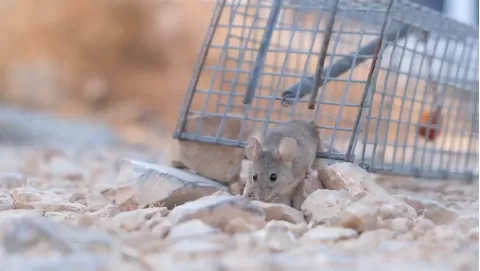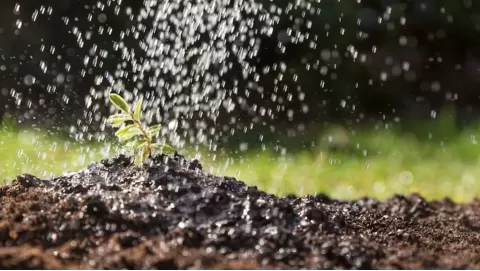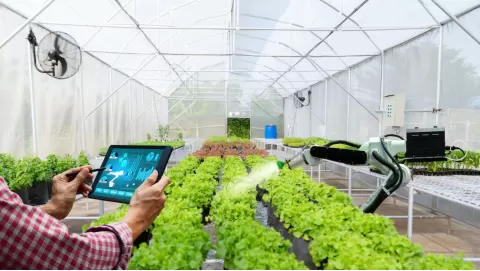
Automating Harvest and Post-Harvest Operations with Precision Technology
Modern agriculture is under increasing pressure to become more efficient and cost-effective while needing to meet changing demands, resulting in automation as a game-changing realization. Producers are looking to make operations more efficient, smarter through harvest to post-harvest processing that does not compromise quality or control. Due to labor shortages, rising input costs, and the demand for scalable systems, traditional methods hit their limitations.
- What: Automation of harvesting and post-harvest operations using precision technology helps improve productivity, lower labor costs, and enhance product quality. Emerging technologies include automated grain drying systems, scalable storage systems, and high-performance infusion systems that accelerate production from harvest to final product.
- Ideal For: Manufacturers and farmers exploring automation to build efficient, scalable processes while preserving consistency and product quality.
- Key Players:
- Shivvers Manufacturing Inc.: Multi-commodity smart grain drying solutions that maximize grain throughput and minimize energy costs with Continuous Counter-Flow Drying Technology.
- BMH Equipment: Modular storage systems designed for optimal space management and access across agricultural operations.
- Sorting Robotics: Precision automation for infusion, accurate dosing, and volume scaling in high-demand manufacturing environments.
- Pro Tip: Integrating automation systems can boost operational efficiency while enabling predictive maintenance and unlocking valuable data-driven insights.
Precision automation is the answer, enabling greater productivity, less waste, and standardized outcomes throughout the workflow process. And new first-of-its-kind technology in grain drying at harvest time, in optimizing post-harvest storage, and in allowing for automation of infused product manufacturing delivers measurable value today and long-term sustainable advantage.

In this article, you can explore how innovative companies, Shivvers Manufacturing Inc., BMH Equipment, and Sorting Robotics are changing what is possible in agriculture moving forward. Their approaches not only solve today’s problems but also help establish integrated, high-performing operations that will be able to scale as they succeed.
Solving Harvest-Time Bottlenecks with Smart Drying Solutions
When it comes to harvest season, timing is key. The time between getting grain off the field and into storage is limited, and delays in that process can result in lost yield and reduced quality or spoilage. This is when drying efficiency becomes a mission-critical thing.
Bottlenecks often get created by traditional manual drying systems. They need constant monitoring, involve guesswork, and may not be fast enough to keep pace with large harvest flows. In comparison, smart drying systems have built-in automation that cuts out downtime and increases throughput.
Farm profitability is based on much more than just yield—it's about maintaining grain quality with the fewest amount of energy and labor inputs. Automated grain dryers provide the ability for producers to dry faster, more evenly, and at lower fuel usage while achieving or improving test weights. This maximises the grain market value and overall harvest operations efficiency.
Streamlining Grain Harvest with Shivvers Manufacturing Inc.
With over 55 years of experience, Shivvers Manufacturing Inc. has become a trusted name in grain drying innovation. For farmers of all sizes, their dedication to quality, automation, and performance has enabled them to keep pace with the growing pressures of modern agriculture.
Shivvers understands that efficiency isn’t just about how quickly a piece of equipment can complete a task; it involves intelligent systems, fine-tuned for various crops in various conditions, working 24/7. Their technology is designed to reduce labor, create uniformity in drying and to optimize every mile of the harvest.
Continuous Counter-Flow Drying Technology
At the heart of Shivvers’ innovation is its Continuous Counter-Flow Drying Technology—a significant advance from traditional batch drying techniques, unlike many outside systems, which dry grain in large, stationary batches, Shivvers’ technology enables a continuous flow of grain through the system.
This method enables more even drying, reduces energy use dramatically, and increases the speed of the whole process. This is a perfect solution for producers who want to increase throughput but maintain their grain integrity.
Multi-Crop Versatility and Increased Test Weights
Flexibility is one of Shivvers’ greatest assets. Their systems are designed to accommodate a range of agricultural products from corn and soybeans to wheat, switching from one to another as necessary.
Furthermore, accurate drying control improves test weights, which in turn affects profit. Larger test weights mean better quality ratings and increased value of pure per bushel. Producers are drying smarter, maximizing efficiency, and getting more from each and every harvest with Shivvers.
Reimagining Storage Infrastructure for Agricultural Efficiency
Storage after harvest is not always the star of the show, but it should be. Reckless supplies can rapidly upset productivity, organization, and profitability after all the work of planting, growing, and harvesting.
Old, undersized storage systems build an unseen bottleneck. Items get buried, tools scatter, and valuable square footage is not used effectively. This results in these inefficiencies weighing on operations and costly delays, particularly in peak seasons.
And it needs to be space-efficient, scalable, and maybe even smart storage solutions as innovative day farms have both of these issues on their plate. These are the essential characteristics that make up a post-harvest landscape today in terms of efficient space utilization, access, and flexibility. With the right infrastructure in place, there are smoother workflows, quicker turnaround, and an optimized use of every square foot.
Optimizing Post-Harvest Storage with BMH Equipment
Traditional storage configurations just can’t keep up with the changing requirements of modern ag companies. The larger the operation, the greater the need for accessibility and storage capacity.
Lack of proper layout design and space leads to clutter, inefficiencies, and increased labor. Finding what you need shouldn’t take more time than actually doing the work. That’s where BMH Equipment steps in.
BMH understands that agricultural storage isn’t just about space—it’s about smarter space. Their storage systems are designed for easy movement, increased productivity, and business growth.
BMH’s Modular Storage Systems
BMH offers a range of modular solutions, including vertical lift modules, mobile shelving, and modular casework, each one engineered for precision and performance.
Vertical Lift Modules (VLMs) employ automated systems that retrieve items quickly to minimize wasted time, as well as maximize the volume of space (versatile for vertical use). Mobile shelving units are high-density storage that run on tracks, removing dead zones, freeing up space when you need it most.
Modular casework is designed for adaptability; it can be reconfigured over time as requirements change. All together, these systems offer unprecedented scalability, ergonomics, and customization to agricultural storage.
Sustainability and Smart Expansion
BMH’s systems not only free up space, but they also cut down the need for costly warehouse changes. More efficient use of existing footprints can postpone or reduce the need for new construction.
These solutions also reduce operational expenses by better tracking inventory and eliminating wasted labor. BMH helps you store smarter and grow free of the hassle, be it tools, seeds, packaging materials, or equipment parts.
Scaling Infused Product Manufacturing with Automation
Functional products like infused teas, wellness beverages, and nutraceuticals are gaining serious traction in today’s health-conscious market. Consumers are looking for more than just flavor — they want benefits, consistency, and clean delivery methods.
Manufacturers are up against real challenges as demand grows. Even the most experienced teams can face challenges in achieving precise dosing, maintaining batch consistency, and meeting tight production timelines. Internal manual processes are inefficient, leaving the potential for variability and increased labor costs.
That’s why automation is a must—not just for efficiency but also for compliance. The use of precision systems achieves repeatable, accurate dosing and removes variation that can lead to product inconsistency, allowing brands to meet consumer and regulatory expectations with confidence.
Revolutionizing Infused Product Manufacturing with Sorting Robotics
Today’s market is defined by quality. Consumers desire infused products that provide reliable effects, premium presentation, and zero guesswork. For manufacturers, that means an urgent need for speed, scalability, and precision.
Manually operated infusion systems typically yield inconsistencies, costly labor, and low throughput. It must be handled extensively for each unit sold, which means a higher likelihood of error and less profitability.
Sorting Robotics is changing the game by bringing cutting-edge automation to infused product manufacturing—bridging the gap between craft quality and industrial scale.
Sorting Robotics’ Suite of Automation Tools
Sorting Robotics provides a set of specific automation tools that allows infused product manufacturers to improve production while maintaining high-quality outcomes:
| Stardust | |
|---|---|
| Feature | Benefit |
| The Only Kief Coating Machine | Stardust is the first machine to automate kief coating, a breakthrough in the industry and the only kief coating machine available. |
| Unmatched Precision | Stardust redefines a labor-intensive craft into a highly profitable production line with precision customized profile controls and entirely even coverage. |
| Performance at Scale | Able to fill up to 1,200 joints per hour, with high efficiency without the loss of quality. |
| Versatile Compatibility | Compatible with cones, straight tubes, and blunt, meeting diverse production needs. |
| Jiko Standard | |
|---|---|
| Feature | Benefit |
| Infuses 1,000 Joints per Hour | Jiko standardizes the infusion process with up to 1,000 infused pre-rolls delivered each hour. |
| Works with a Range of Concentrates | Accommodates distillate, rosin, and other concentrates for versatile processing. |
| Real-Time Production Tracking | Tracks throughput production data, in real time, to maintain continuous operational efficiency and to hold people accountable. |
| Jiko+ | |
|---|---|
| Feature | Benefit |
| Designed for Premium Infusions | Jiko+ was designed with high-viscosity concentrates in mind, like rosin, for premium infusion experiences. |
| Handles the Toughest SKUs | This is designed to take thick, high-potency concentrates—great for hash holes or even core-infused pre-rolls. |
| High-Throughput Capability | Infusibility up to 1,200 joints/hour for high-demand operations. |
| Advanced Heat Control | Means accurate dosing and reproducibility of batches. |
| Consistency and Quality | Shapes, depth, and placement of the concentrate is preserved for every batch from the original pan, guaranteeing a high-grade product every time. |
Sorting Robotics helps manufacturers advance their capabilities, automate complicated tasks, and scale with no sacrifices, all without giving up the craft-level quality that differentiates their brand on a global stage.
Key Benefits of Automating Harvest and Post-Harvest Operations
Labor Efficiency and Workforce Optimization
Labor shortages, a critical challenge to agriculture, can be significantly eased through automation. By automating repetitive tasks, operations can free up human labor for more strategic roles that add value to the organization. It not only increases productivity but also helps to optimize operational efficiency.
Product Quality and Consistency
Automated farming systems keep things including moisture levels and dosing consistent. This ensures better quality products with reduced human errors and improved shelf life. That way, brands can create trust in their products and earn loyalty.
Time and Cost Savings
Automation quickens throughput by bringing products from the field to the final product faster. The reduction in manual labor and operational energy costs also brings significant financial savings, making the entire process more efficient and profitable.
Data-Driven Insights for Better Decisions
At the same time, automation generates valuable big data, which is integral for the decision-making process of real-time control systems. Analytics drives everything from forecasting and predictive maintenance to the ability to scale operations. Providing this information helps optimize management and improve decision-making throughout the entire production process.
The Future of Farm and Facility Integration
All systems, from harvesting grain to functional products, continue to connect products. This results in intelligent, seamless processes that make operations a lot more efficient. Modular solutions enable facilities to adapt, scale, and fit seamlessly to changing needs.

Automation for each facility — not a one-size-fits-all solution. There is no one-size-fits-all in farming. In-depth consultation and integration support are offered by the companies to design custom systems that can perfectly fit the requirements of any operation while maximizing efficiency and flexibility.
Leveraging Machine Learning and AI for Enhanced Agricultural Operations
In the farming industry, these advanced technologies are also used for better optimization and farming operations using machine learning algorithms and artificial intelligence. The application of artificial intelligence on top of precision livestock farming and post-harvest processes could also enable greater personalization since it can optimize everything from yield to quality control. These technologies enable real-time and automated monitoring and decision-making, which enhances operational outcomes and food safety.
Technological innovations, data-driven automation, and machine learning models are disrupting agriculture supply chains today. It introduces new processor technology that employs advanced sensor systems to improve data management, eradicate human error, and optimize storage facilities. This makes products last longer, which is good for the environment. These innovations help ensure that agriculture is a profitable industry, as well as one that implements sustainable practices on the production line through the use of machine learning.
Empowering Small-Scale Farmers with Advanced Harvest Automation Technologies
To make farming processes more effective and efficient, small-scale farmers are using advanced technologies such as support vector machines and other AI-driven systems. These are the technologies to create easy data collection and to make a person decide in real time, allowing farmers to do activities that are labor-intensive and human intervention-heavy in an automated manner. So, harvest automation and manufacturing robots grant interesting and valid solutions for high-productivity and quality products improvement in post-harvest technology.

Automation will allow small farmers to reduce labor costs and improve the quality and precision of cleanup and food production with farm equipment automation and harvesting robots. Such innovations serve as catalysts for rural development because they enable farmers to scale up and stay competitive.
Armed with data — and, increasingly, machine learning — from near-real-time feeds, small farms are finding new, alternate, sustainable, profitable modes of working that will carry the agricultural sector forward into a new kind of vigor. Many automation solutions align with green goals and ESG (Environmental, Social, and Governance) strategies. They contribute to sustainable growth by supporting circular and regenerative practices, ensuring that farming practices are responsible, scalable, and in harmony with long-term environmental goals.
FAQs
1. How has automation contributed to the efficiency of grain drying?
Improved grain drying with automation — it shortens downtime, improves energy consumption, and enables a more even drying moisture level. That said, for consistent drying, which preserves the quality of grain and maximizes yield savings on energy costs and labor, Shivvers Manufacturing Inc.’s Continuous Counter-Flow Drying Technology is a prime example of this type of system.
2. How can automated systems assist small-scale farmers?
Obviously, small to medium farmers will make a lot of advantages from automation technologies as well. Real-time monitoring combined with AI-based systems and agricultural robots enable these farmers to view and even carry out the harvesting and post-harvest processes accurately, improving accuracy and optimizing and reducing the cost of labor, resulting in an overall increase in yield. These solutions also help farmers maintain competitiveness and build sustainable businesses.
3. What are the benefits of modular storage systems in agriculture?
A good example of this is modular storage systems such as BMH Equipment, which help make storage spaces more space efficient, accessible and streamline the entire process. As they are completely customizable and scalable, you can space them in an efficient manner as per space availability, which helps you avoid unnecessary clutter plus minimizes the burden of managing and tracking inventory. They also allow for necessary reductions in new construction, which are inexpensive, and can be expanded as needed for storage.
Conclusion
The integration of automation and precision technology in agricultural operations is revolutionizing the industry, offering smarter, faster, and more sustainable ways to manage harvest and post-harvest processes. With grain drying efficiency, cutting-edge storage systems, and recent infused product manufacturing, automation makes it easier for agricultural operations to scale without sacrificing quality or profitability. With these innovations, both smaller and larger farms will be able to meet the needs of modern agriculture with increased precision and efficiency as the agriculture industry adopts these technologies.
Disclaimer: This material is for informational purposes only and should not be relied on for legal, medical, financial, or other professional advice.
Sources:
ScienceDirect- Postharvest
ResearchGate- Recent Advancements and Innovations in Post-Harvest Handling, Storage, and Technology for Vegetables: A Review

























